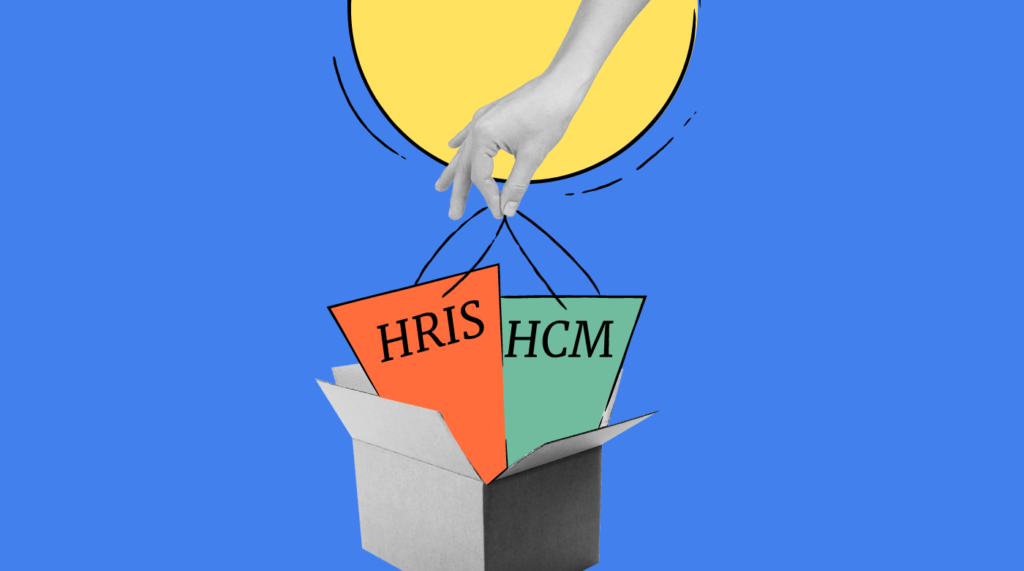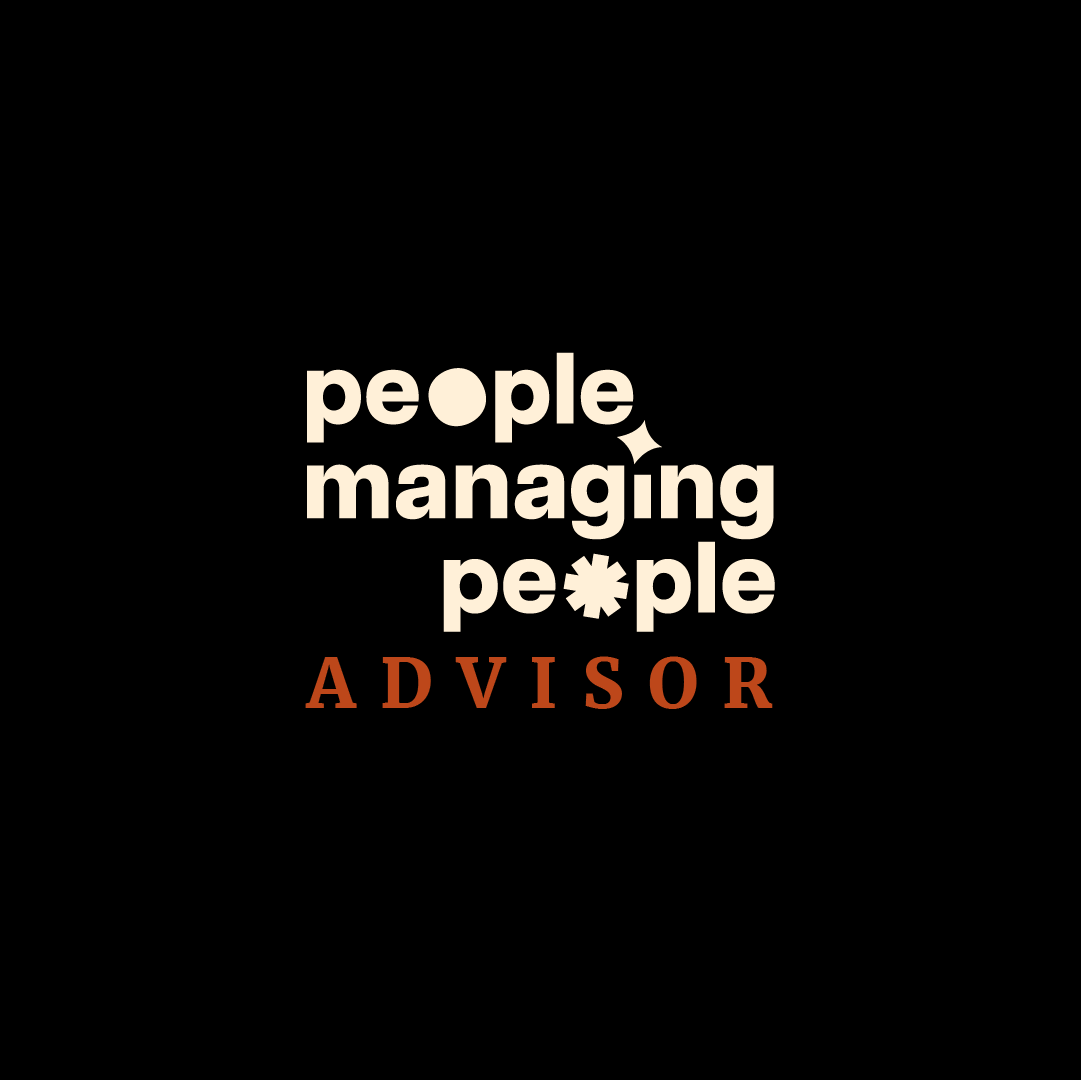So, you know what an HRIS and HRMS are, and you've got an understanding of HCM—but do you know the difference between these types of HR systems?
In this article, I'll explain the main points you should know about HCM software, HRMS, and HRIS systems:
- What is an HRIS?
- What is an HRMS?
- What is HCM Software?
- How are HRIS, HRMS, and HCM Systems Similar?
- How are HRIS, HRMS, and HCM Software Different?
- How To Choose Between HRIS, HRMS, and HCM Solutions
Read on to learn how these systems can benefit HR professionals.
What is an HRIS?
A Human Resources Information System (HRIS) is a type of HR software used to manage core HR functions like storing employee data. These systems provide easy-to-access, streamlined information. By storing all employee information in one place, it removes the stress of multiple spreadsheets, databases, and paperwork overload.
Depending on the sophistication, an HRIS system can help human resource teams with providing:
- Payroll
- Benefits administration
- Training records
- HR reports
- Time-keeping
- Remote schedule management.
Benefits of an HRIS
The main benefit of HRIS software is that it allows your HR department to access employee records in one location. This removes the need to juggle competing systems to track various aspects of information your HR specialists need to make business decisions.
Streamlining with an HRIS translates to more productivity, increased cohesiveness across your entire business, and a better employee experience.
HRIS systems utilize these seven key tools to take HR management to the next level:
- Core HR
- Payroll
- Employee Benefits
- Training
- Performance Management
- Time Tracking and Leave
- Onboarding

What is an HRMS?
A human resource management system (HRMS) is a more robust type of HR management system that helps organizations manage their employee data, as well as key HR processes such as recruitment, payroll, benefits, training, and performance evaluations. They are similar to HRIS systems in that they cover the same core HR areas. However, there are some key differences.
HRMS systems offer a greater ability to automate HR tasks across the full employee lifecycle, while HRIS systems are more focused on alleviating the woes HR teams face regarding data entry and data management.
Because of their more advanced functionalities, HRMS are generally the most expensive variety of HR management software.
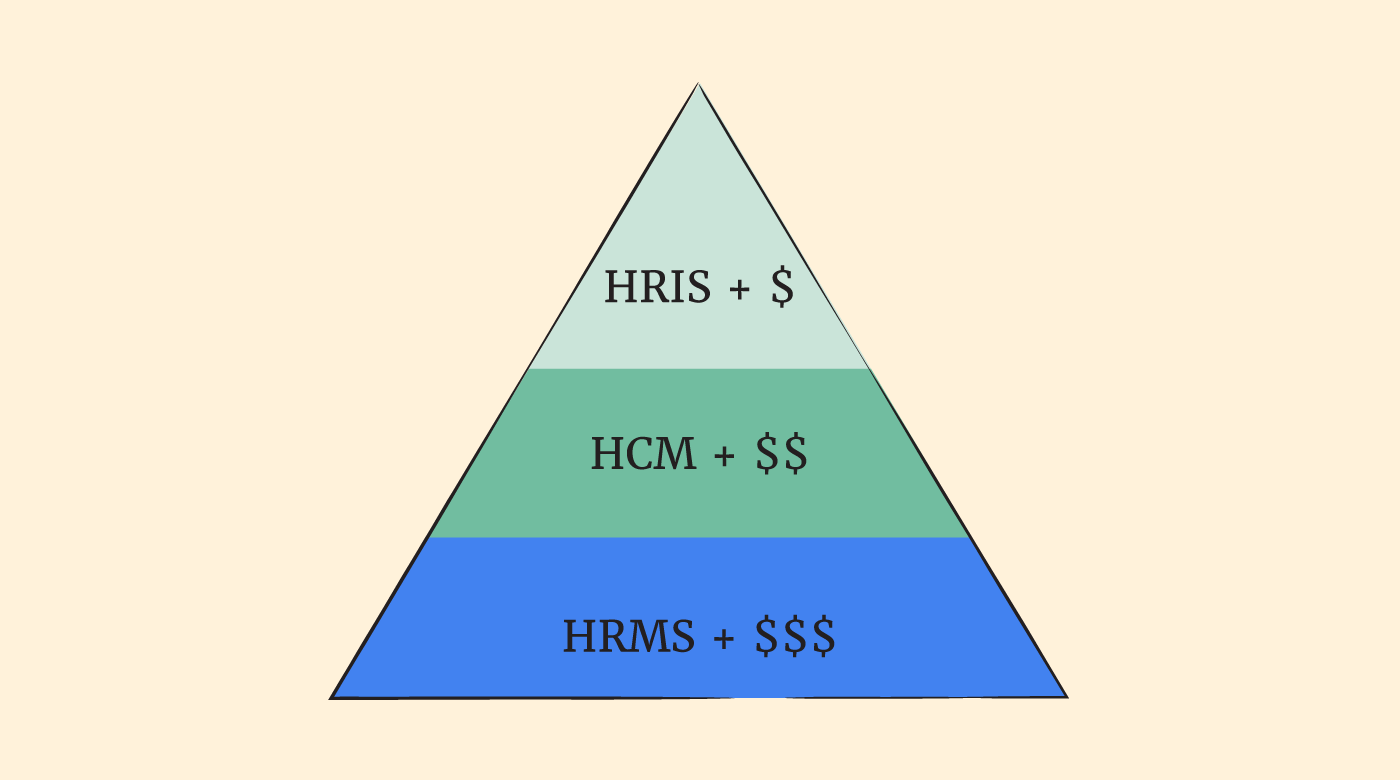
Benefits of an HRMS
Using an HRMS can offer numerous benefits to HR teams. Thanks to their interconnected modules, they can automate many administrative tasks, reducing the amount of time your staff need to spend on time-consuming tasks.
Other benefits of using HRMS software include:
- Improved data management practices
- Automatic compliance monitoring flags
- Enhanced employee self-service
- Improved decision-making from integrated data analytics
HRIS & HRMS Quick History
In the 1960s and 1970s, large businesses began managing their employee data with HR software. At the time, their main goal was to aid in records management and meet legal documentation requirements.
Early HR software focused mainly on payroll and was produced on mainframe computers that served as central data stores with little ability to process or interact with the system.
HRIS then became more popular in the 1980s when Enterprise Resource Planning (ERP) systems gained momentum in the business world. This began a shift from mainframe systems to client-server technology.
Businesses were now able to visualize the big picture of their company needs, and leaders began to understand that relationships with people – employees and customers – made a big difference in the level of their success.
Today, the term HRIS is used interchangeably with human resources management system (HRMS).
What is HCM Software?
Human Capital Management (HCM) utilizes the same processes of HRIS and includes talent and workforce management. An HCM solution puts an emphasis on a strategic approach to managing employees.
Some areas HCM software covers include:
- Talent acquisition
- ATS (applicant tracking system)
- Onboarding
- Talent management
- Culture-building
- Career pathing
- Competency mapping
- Succession planning
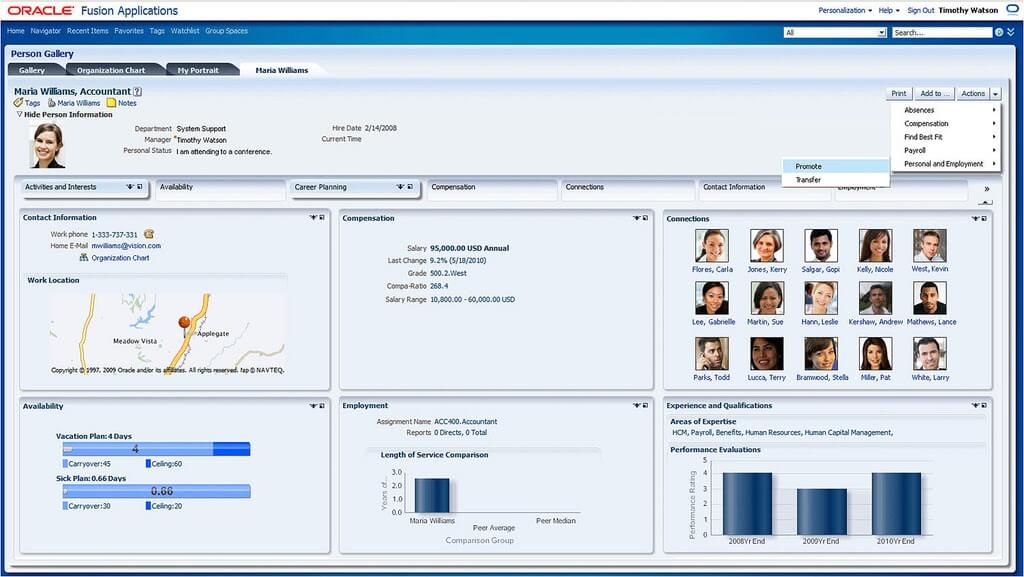
Benefits of an HCM
In addition to the benefits of an HRIS, HCM software provides data and analytics that can be used for planning long-term goals in your business. Other benefits include:
- Better data-driven decision-making
- Improved employee satisfaction
- Improved retention rates
- More efficient workforce planning
- Enhanced company culture
HCM Quick History
In the 1950s and 1960s, the term “Human Capital” emerged as business leaders began to understand the value of employees.
Employees across industries began to be seen by management as valuable team members with skills and abilities to help fuel the growth of their companies - rather than just bodies on a production line or employees who could be easily replaced.
When use of the internet began to rise in the 1990s, so did the need for leaders to transform their practices. Everything from recruitment, talent management, engagement, and employee retention had to be re-evaluated and updated.
Enter HCM systems to manage these HR needs in a streamlined way.
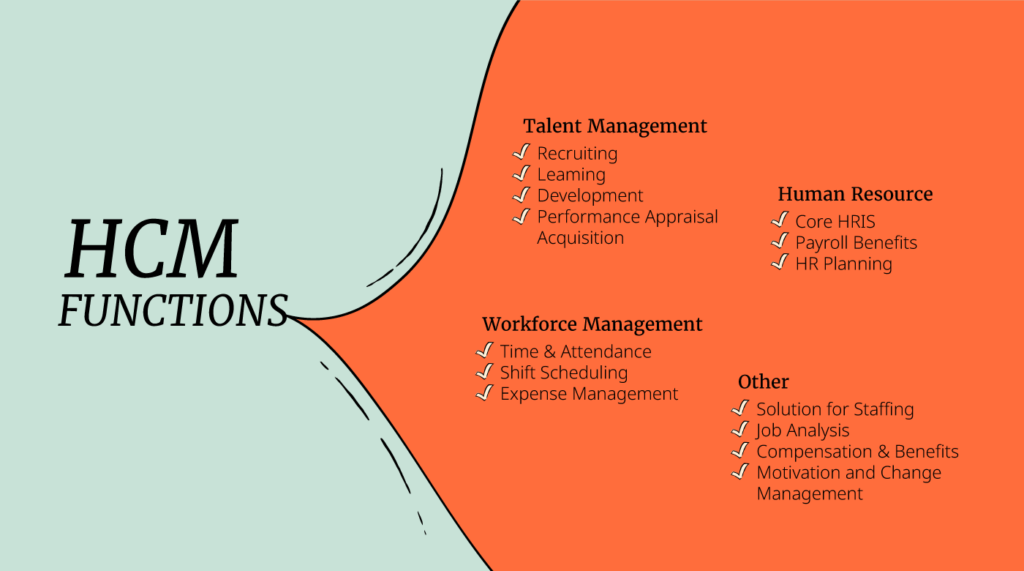
How are HRIS, HRMS, and HCM Systems Similar?
HRIS, HRMS, and HCM are all types of human resource management systems that support many of the same cloud-based HR functions, such as:
- Managing payroll
- Storing employee demographic information
- Recording performance management information
- Providing self-serve options
- Maintaining employee training records.
How are HRIS, HRMS, and HCM Software Different?
The main difference between HRIS, HCM, and HRMS tools has to do with the depth and breadth of their HR coverage. An HRIS handles core HR functions, while HCMs drill down into more employee-centric processes, with HRMS software offering even more comprehensive features.
An HRIS covers all basic HR functions, but from a data management and data capture perspective. All of your employee details are in one place, but you have fewer tools to take action with that data.
HCM software gives you the ability to engage fully on an employee-specific level in areas like employee performance, analytics, and onboarding while HRIS provides more basic-level employee data.
HRMS systems take things one step further than both HRIS and HCM software. They offer a broader set of features and more advanced functionalities, such as integrated analytics from workforce data to support strategic planning.
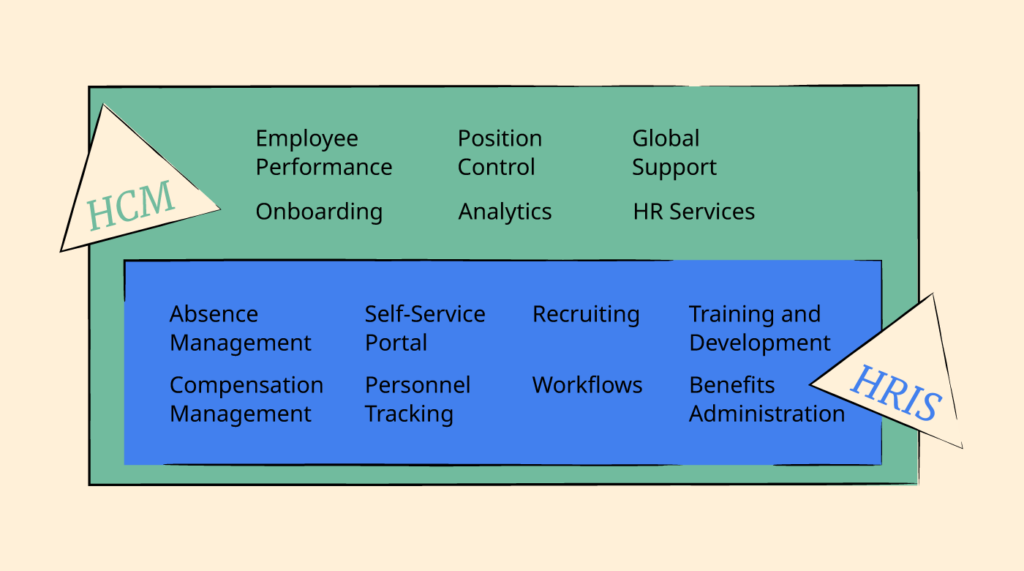
How Do You Choose Between HRIS, HRMS, and HCM Solutions?
The decision of which of these software solutions to choose depends on your specific business needs.
Ask yourself these questions to help determine which is best for you:
- What are your main HR functions and specific needs?
- What's the current status of your HR technology?
- Is employee engagement a valid need in your business?
- What areas of your business could be streamlined?
- How do you manage employee data?
- What does your onboarding process look like?
- Is talent management needed in your business?
- Is there a need for succession planning?
Finding the best HR software for you can be a relatively long process, but putting in the time and research will ensure you make the right decision for your HR professionals.
And if you're looking to get certified to better handle decisions like this, here's A Comprehensive Guide To HRIS Certifications you might want to take a look at!
Need expert help selecting the right Human Resources (HR) Software?
If you’re struggling to choose the right software, let us help you. Just share your needs in the form below and you’ll get free access to our dedicated software advisors who match and connect you with the best vendors for your needs.
Stay in Touch
People Managing People exists to help experienced managers, leaders, and culture creators connect and share knowledge.
We’re dedicated to providing the resources and support you need to serve your people well. Join our People Managing People newsletter to stay up-to-date on the latest and most effective HR practices.

